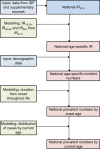Type 1 diabetes in 2017: global estimates of incident and prevalent cases in children and adults
- PMID: 34599655
- PMCID: PMC8563635
- DOI: 10.1007/s00125-021-05571-8
Type 1 diabetes in 2017: global estimates of incident and prevalent cases in children and adults
Abstract
Aims/hypothesis: Data on type 1 diabetes incidence and prevalence are limited, particularly for adults. This study aims to estimate global numbers of incident and prevalent cases of type 1 diabetes in 2017 for all age groups, by country and areas defined by income and region.
Methods: Incidence rates of type 1 diabetes in children (available from 94 countries) from the IDF Atlas were used and extrapolated to countries without data. Age-specific incidence rates in adults (only known across full age range for fewer than ten countries) were obtained by applying scaling ratios for each adult age group relative to the incidence rate in children. Age-specific incidence rates were applied to population estimates to obtain incident case numbers. Duration of diabetes was estimated from available data and adjusted using differences in childhood mortality rate between countries from United Nations demographic data. Prevalent case numbers were derived by modelling the relationship between prevalence, incidence and disease duration. Sensitivity analyses were performed to quantify the impact of alternative assumptions and model inputs.
Results: Global numbers of incident and prevalent cases of type 1 diabetes were estimated to be 234,710 and 9,004,610, respectively, in 2017. High-income countries, with 17% of the global population, accounted for 49% of global incident cases and 52% of prevalent cases. Asia, which has the largest proportion of the world's population (60%), had the largest number of incident (32%) and prevalent (31%) cases of type 1 diabetes. Globally, 6%, 35%, 43% and 16% of prevalent cases were in the age groups 0-14, 15-39, 40-64 and 65+ years, respectively. Based on sensitivity analyses, the estimates could deviate by ±15%.
Conclusions/interpretation: Globally, type 1 diabetes represents about 2% of the estimated total cases of diabetes, ranging from less than 1% in certain Pacific countries to more than 15% in Northern European populations in 2017. This study provides information for the development of healthcare and policy approaches to manage type 1 diabetes. The estimates need further validation due to limitations and assumptions related to data availability and estimation methods.
Keywords: Adults; Children; Epidemiology; Global estimates; Incidence; Prevalence; Type 1 diabetes.
© 2021. The Author(s).
Figures



References
-
- World Health Organization . Global action plan for the prevention and control of noncommunicable diseases 2013–2020. Geneva: World Health Organization; 2013.
-
- World Health Oragnization . Global report on diabetes. Geneva: World Heath Organization; 2016.
Publication types
MeSH terms
Grants and funding
LinkOut - more resources
Full Text Sources
Medical

